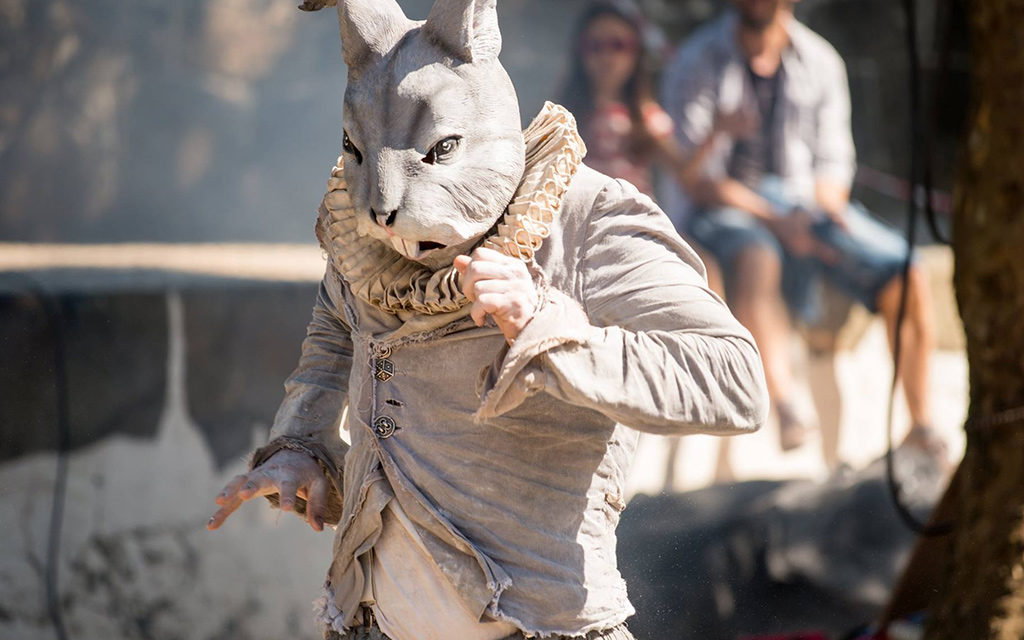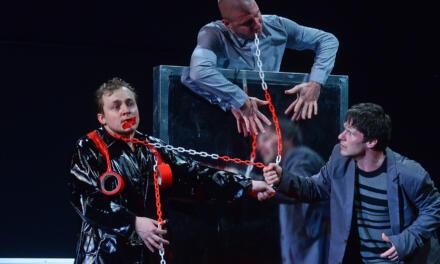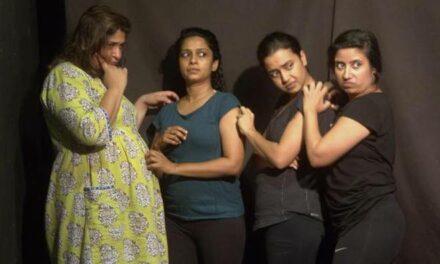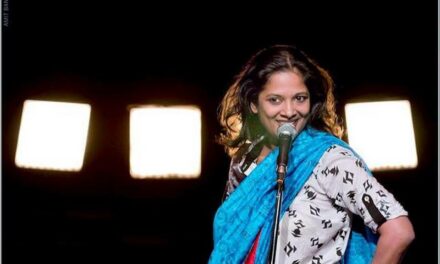A Dalit family openly flogged by gau rakshaks for skinning a dead cow, found their extended public ordeal became the focus of nationwide protests when a viral video of the incident spread online in July last year. This occurred at a time when the lacerations caused to the national psyche by Rohith Vemula’s suicide in January, were still tender to the touch. His eloquent suicide note became an emotive clarion call for embittered souls everywhere, who continue to be subjugated by systems of oppression that persist in the country.
Scenes to behold
At the International Theatre Festival of Kerala (ITFoK), a nine-day jamboree which drew to a close on February 28, the brutalization of Dalits and other marginalized groups was brought out for public airing by a raw and powerful street theatre piece. Directed by theatre activist Ramachandran Mokeri, the production is titled I am Rohith Vemula. At the outset, the cadaver of a calf (made of polystyrene) was butchered, and its bloodied entrails distributed to onlookers like an offering. Clad in the style of a vintage-era rock star, Mokeri strummed at his guitar as he led a procession through Thrissur’s busy streets, quoting from Vemula’s note in a guttural voice relayed via loudspeakers. The crowds joined in for a long walk that took place partly along the Swaraj Round — the biggest roundabout in South Asia — before coming in to roost at the Kerala Sangeetha Nataka Akademi, the primary venue for the festival. Accompanying Mokeri was a motley crew of actors. Their bodies, in various stages of undress, were branded with black markings, their keen dark eyes glinted with deprivation, and their lips were a trembling red. Some were dragged across the road, others lashed. As an image relentlessly thrown at onlookers during the course of a two-hour yatra, it certainly registered as a powerful reminder of atrocities that otherwise no longer shock. The people on the streets clapped and cheered and raised slogans, mirth mingled with awe at the theatrics of it all, but perhaps also took home some of the pain and the agony.
The festival’s focus this year was street theatre, and its counteractive tone was set on the very first evening by Sankar Venkateswaran’s short piece, Udal Uravu Uyirezhuthu Udaleduppu, in which firebrand actor K Gopalan subjected himself to a shower of nails. National and international acts took the festival to the streets with whimsy and derring-do, outrage and humour. Unlike the didactic street-plays commonly associated with the form, the programme threw up works that engaged with live audiences in clever disarming ways. For instance, Arrived, by the Spanish-Lithuanian pair Adrian Schvarzstein and Jūratė Širvytė-Rukštelė. Appearing out of nowhere at the town square – dressed as old-world travelers with leather suitcases that played vintage tunes – the duo engaged intimately with the throng that had gathered. As they chased the Pied Pipers, onlookers ran and tumbled, peered over shoulders, pulled each other aside, looked through car windows, and laughed with abandon at almost every turn. Traffic came to an absolute standstill, as pedestrians ruled the streets, trying to keep up with each adventure the beguiling strangers conjured up. They collected mobile phones and redistributed them, or crammed cars with strangers before flagging them off with fanfare. A desultory afternoon was transformed into something magical.
During the festival, Schvarzstein and his Kamchàtka group from Spain workshopped with local participants, unleashing them on an unsuspecting populace for a presentation along the lines of Arrived, on February 25. While they were a similarly intriguing bunch, they were constantly in danger of running out of the surprises a strange city throws up for the uninitiated. Schvarzstein also directed the Italian actor, Marco Mannucci in Out!, a non-verbal performance that conveyed much about star-crossed lovers, human frailty and the triumphs of perseverance. Thrown out of their home by his tetchy inamorata, an intrepid Mannucci attempted to climb back into the apartment, with the aid of a series of contraptions ostensibly left behind by construction workers. The actor who had long-standing experience in flight techniques set himself up for a series of precarious miscarriages. It is a piece that strung together unsatisfactory moments like they were pearls, and Mannucci spectacularly endeared himself to the crowd who egged him on even if his romantic quest seemed doomed.
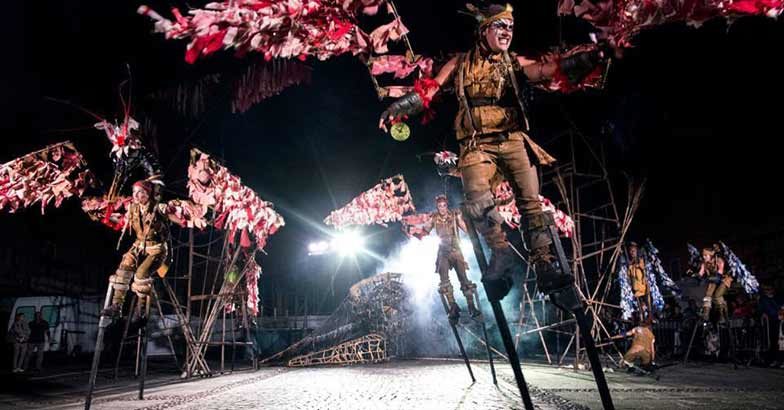
Pentesilea. Directed by Stefeno Tee, Teatro Dei Venti, Italy. The International Theatre Festival of Kerala, 2017. Press photo
Other highlights
A piece that dealt with subtle transformations was Mbalou Arnould and Nella Turkki’s Strings, performed by Arnould and three local actors who had rehearsed together for only three days. Staged around a huge banyan tree, extensible cords linked the performers to one another. They negotiated the space like human marionettes, paths and gestures intertwined, yet still achieving a delicate synchronicity that allowed each performer a measure of individualism. When audience members replaced the actors, the interplay teetered at the edge of an incipient confusion, but each linkage found its own playing ground.
Elsewhere, at the Kinattingal Tennis Club, in a venue recently christened the Om Puri Space, Erin B Mee’s Pool Play was performed by a spirited ensemble of actors. It was a piece that tried hard to offset the great American ennui with the inviting waters of the swimming pool in which it was performed; a setting that it did not entirely embrace. But, choreographer Jonathan Matthews in a vintage bathing costume delightfully if somewhat kitschily evoked the ‘aquamusical’ artistry of Hollywood great Esther Williams with his synchronized swimming act.
Amidst hillocks and bamboo thickets, at the School of Drama campus in the University of Calicut, Sreejith Ramanan presented an evocative if patchy re-imagining of an age-old epic, Misty Mountains of Mahabharata. The opening overture saw the predominantly male ensemble emerge literally from the ground, clad in primordial loincloths, like engorged roots or sinewy branches caked in soil. The sage Vyasa (a sprightly Sumesh Moor) was presented as the wellspring of the play’s narrative themes, and as a fount of seminal energy in a hyper-masculine world. The prologue saw him precariously perched on swaying bamboo culms as he set the karmic wheel into motion from that elevated vantage. The game of dice was presented as a zestful phallic interchange which was certainly diverting. Yet, while trying to cover as much ground as possible, the piece sometimes had a swiftness of stride, but very often meandered, not always satisfactorily. Interestingly, this telling of the Mahabharata sidelines Krishna, and it’s Vyasa who rescues Draupadi from her plight, ferrying her limp body from the court. Hidimbi is represented as a feisty creature, but she is merely the spoils of victory for a bullish Bhima. In a production that comprised entirely of students of the school, the four women in the cast could have been much more than just damsels in distress. It brought to mind the festival’s own perceivable masculine thrust.
While the curators have attempted to create an itinerary that is considerably balanced in terms of its yin and yang, it is almost always the lives of men illuminated each day, with only a smattering of women in attendance.
This article was first published on thehindu.com and reposted with permission of the author. Read the original article here.
This post was written by the author in their personal capacity.The opinions expressed in this article are the author’s own and do not reflect the view of The Theatre Times, their staff or collaborators.
This post was written by Vikram Phukan.
The views expressed here belong to the author and do not necessarily reflect our views and opinions.

